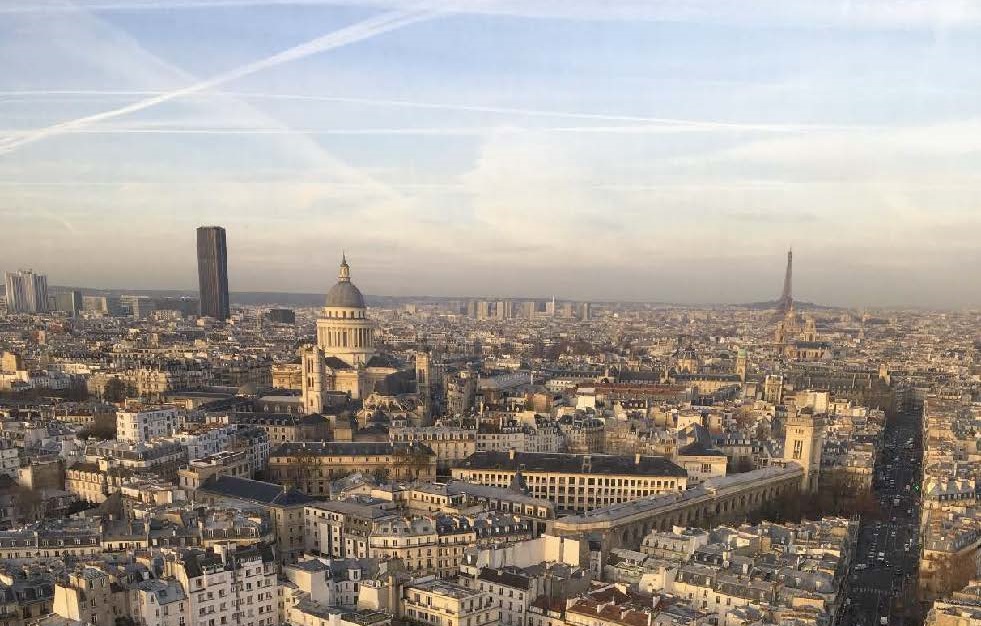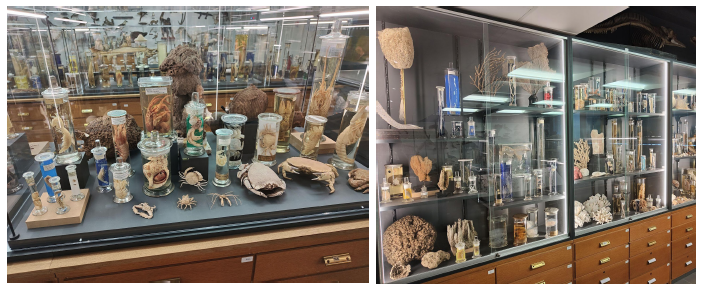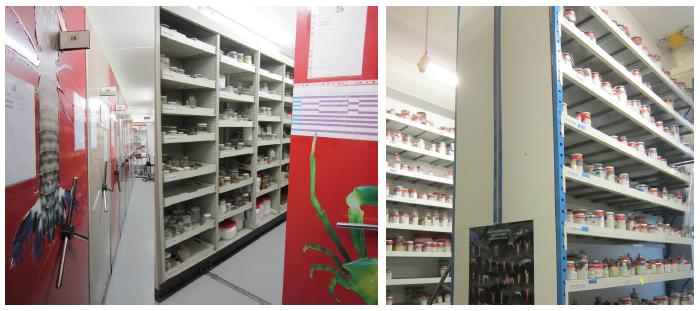
|
|
|
Side events
Panoramic view from the Zamansky Tower
Enjoy one of the best views of our city from the 24th floor of the Zamansky Tower on Sorbonne University campus on Tuesday July 8th (groups of 10-15 guests, 20 minutes each)

Collection visits
1. For fun
On Wednesday July 9th, visits to 4 different collections are possible: the collections of the Sorbonne University (Zoology collection, Geosciences collection) and the MNHN collections (Crustacean typotheque, Extant crustacean collection) will be organized upon registration by the curators in charge of the collection unit concerned.
In Sorbonne University
Zoology collection
Heir to the former zoological collection of the Sorbonne, this is an important collection of objects for educational purposes: fluid specimens, naturalisations, skeletons, anatomical montages, etc. It includes historical pieces, such as an elephant skull from the cabinet of Georges Cuvier, and remarkable sets such as the Frič collection of comparative anatomy (late 19th century).
Visit hosted by Santiago Aragon

Geosciences collection
The geoscience collections of Sorbonne University are intimately linked to the history of the Sorbonne's geology laboratory, created in 1857 by Edmond Hébert, a pioneer in palaeontology. Thanks to meticulous paleontological collections throughout Europe, Hébert increased the collections of the first holders of the chair of geology, presiding over the progressive constitution of one of the richest collections in France. Preserved on the Pierre and Marie Curie campus, the collections now include tens of thousands of specimens, divided into several sub-collections. A “typology library” houses typed and figured specimens belonging to the collections of Sorbonne University.
Visit hosted by Stéphane Jouve
(https://www.sorbonne-universite.fr/en/culture-and-outreach/noteworthy-places-collections-and-bequests/outstanding-collections-and)
--------------------------------------------------------------------
In MNHN
Extant Crustacean Collection
The Crustacean collection of the Muséum national d’Histoire naturelle gathers all decapods and non-decapods as well as Pycnogonids and Horseshoe crabs. Composed of more than 160,000 inventoried lots, and about 15,500 types, this collection is considered as one of the richest Museum collections, most notable by the species diversity as well as the geographic coverage. It is the largest collection of deep-sea decapod crustaceans from the Indo-Pacific zone.
The collection includes marine, freshwater, and terrestrial crustaceans (including parasitic species) from all over the world. The specimens, measuring from less than 1 mm to more than 2 m in width, are mainly preserved in alcohol. Some are naturalized and dry-preserved (historical collections, such as the Brachuyra Collection), others are preserved in preparations on slides. Since 2008, tissue and DNA collection has also been set up.
Historically, the core of the collection started before 1800 with the harvests of the naturalist travellers (voyages of Bougainville, Savigny, Dumont d'Urville...) and continued afterwards, notably with those of the expeditions of the “Travailleur'' and the “Talisman”. The collection has benefited from the work of famous carcinologists such as Jean-Baptiste de Lamarck, P.-A. Latreille, H. and A. Milne-Edwards, E. Chevreux. A considerable expansion of the collection is due to the Musorstom and Tropical Deep-Sea Benthos expeditions, which began in the late 1970s and are still ongoing today.
The crustacean collection is housed in two different locations at MNHN. The type material is stored in the Typotheque, and the General collection of extant Crustacea is stored in the Zootheque.

Palaeontological Collection
The collection of fossil marine arthropods at the Muséum contains specimens from all over the world. Many extant and extinct groups are represented: trilobites, eurypterids, pycnogonids, limulids and crustaceans (crabs, shrimps and lobsters).
The collection of fossil marine arthropods is very old and is composed of several palaeontological collections corresponding to a wide variety of classification systems: by locality, by age or by systematics.
The following ones are stored at the Muséum:
-
Large historical collections gathered by prestigious naturalists (e.g. Faujas de Saint Fond, Brongniart, Desmarest, d’Orbigny, Milne Edwards);
-
Stratigraphic collections (e.g. Jurassic of France);
-
Specialised collections relating to consistent taxonomic groups (e.g. crabs of the Desmarest’s collection);
-
Geographical collections (e.g. fossil crustaceans from Madagascar).
The collection contains about 20,000 specimens of fossil marine arthropods including 6,000 trilobites, 2,000 decapod crustaceans and 300 thylacocephalans (enigmatic arthropods that became extinct in the Cretaceous). Over 2,100 type and figured specimens have now been listed.
https://www.mnhn.fr/en/fossil-marine-arthropod-collection
2. For research
Collection research visits
All facilities will be at your disposal to study the numerous types and figured specimens, as well as less known material housed in the collections of MNHN.
Because we will have a limited number of slots (time, space & equipment), and because we expect numerous requests, the number of visitors will be adjusted to the availability of curators and equipment.
Visitors will be welcomed for scientific studies during the 2 weeks before and after the TCS summer meeting 2025 in the collection reserves. A visit should be prepared via our visit management platform: click here. This service makes it possible to record, via the web, a request concerning the collections: loans of specimens, visits, sampling, etc.
-
Extant crustacean collection MNHN
-
Paleontology collections MNHN
The paleontology collections of the Muséum national d’Histoire naturelle store millions of specimens, including fossil crustacean that are the major components of invertebrates and microfossil collections.
The collection of fossil marine crustaceans is very old and includes large historical collections gathered by prestigious naturalists (eg. Faujas de Saint Fond, Brongniart, Desmarest, d'Orbigny, Milne Edwards), stratigraphic collections (eg. Jurassic of France), specialized funds of coherent taxonomic groups (eg. crabs from the Desmarest collection) and geographic collections (eg. crustaceans from Madagascar, crabs from Italy). The collection stores approximately 20,000 specimens of fossil marine arthropods including 6,000 trilobites, 2,000 decapod crustaceans and 300 thylacocephales (enigmatic arthropods extinct in the Cretaceous). More than 2,100 type and figured specimens are now identified.
The micropaleontology collections contain numerous ostracodes, mainly from the Mesozoic. Ostracodology has developed in France for more than a century. Thus, the Museum keeps pivotal collections gathered in particular by Olry Terquem, Nicolas Grekoff, Vespasian Apostolescu and Renée Damotte. About 1,000 type and figured specimens are now identified.
http://www.mnhn.fr/en/collections/collection-groups/palaeontology
--------------------------------------------------------------------
Excursions
There will be no organized excursion for all participants but you will find some proposals for possible excursions in the following links:

